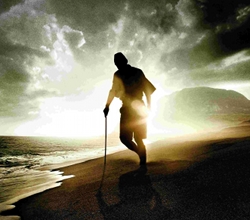Review: Dillinger (1945)
This review is a part of Laura’s Film Noir Genre Spotlight.
Before establishing himself as a weathered thug in films like Born to Kill (1947) and Reservoir Dogs (1992), Lawrence Tierney made his major film debut playing one of America’s most notorious bank robbers.
Clocking in at a brisk 70 minutes, this mostly forgotten crime noir chronicles the illicit career of John Dillinger at breakneck speed. Having robbed more than a dozen banks with his rag-tag group of associates, Dillinger joined the ranks of Bonnie and Clyde and Pretty Boy Floyd as the top newsmakers of the Depression era.
However, Dillinger is not a traditional biopic. The Oscar nominated screenplay by Philip Yordan played it fast and loose with the facts. Yordan chose not to dwell on the motivations that saw Dillinger resort to a life of crime. The film is, essentially, a largely fictitious glossing over of the infamous career criminal who, at the time of the films release, had only been dead for 11 years.
A B-movie from Monogram Pictures, the tiny “poverty row” studio that made a quick buck with low budget films between 1931-1953, Dillinger went on to gross more than 4 million dollars at the box office – this despite its obvious flaws. At the time, Dillinger defied the Production Code’s unofficial rule to relegate real life criminal activity to the background in Hollywood films, likely the reason behind its popularity. No one else in Hollywood would touch the story of Public Enemy #1, leaving the door open for Monogram to adapt Dillinger’s exploits to its own liking.
Riddled with inconsistencies, Dillinger begins with a framing narrative that is quickly abandoned. A theatre audience listens as Dillinger’s elderly father recounts his sons’ misadventures. The film than moves into a flashback of Dillinger’s early introduction to a life of crime and the story proceeds from there. There is no concluding scene that features Dillinger’s father finishing his account.
Another curiosity comes out in the DVD commentary (featuring John Lilius, the director of 1973’s Dillinger) where it’s revealed that the 1945 film actually used stock footage in some of its prominent scenes. Most notably, the tear gas robbery sequence was lifted straight from Fritz Lang’s 1937 film You Only Live Once – complete with a close-up shot of the films star, Henry Fonda, peering out of the back of his car.
Although some have argued against the films classification as film noir, director Max Nosseck utilized traditional narrative devices and visuals often associated with the genre. With its use of flashbacks, albeit briefly, and reductionist lighting, Dillinger features sequences with heavy rain, thick clouds of cigarette smoke and spinning newspapers with bold titles revealing Dillinger’s criminal activity to propel the plot forward. In terms of its aesthetic qualities, the film as aged remarkably well.
However, its strongest facet is Tierney; he makes for a shifty, anxious and explosive Dillinger. Although the character development is kept to the bare minimum you understand he’s a man to be feared – the type of guy who would take serious offense to being called a “two-bit chiseler”. His barely concealed rage simmers just beneath the surface. Tierney doesn’t strive to make Dillinger likeable, opting instead to portray him as an outright villain with questionable motivations.
Its simplistic approach to storytelling propels the action forward, however Dillinger ultimately leaves little impact outside of Tierney’s performance.
-
http://twitter.com/NextProjection Christopher Misch
-
Anonymous
-
http://twitter.com/laura_grande13 Laura Grande
-
http://twitter.com/laura_grande13 Laura Grande
-
Anonymous
-
http://twitter.com/laura_grande13 Laura Grande














 Review: Dogtooth (2009)
Review: Dogtooth (2009) Review: Shame (2011)
Review: Shame (2011) Review: Hugo (2011)
Review: Hugo (2011) Review: Kontroll (2003)
Review: Kontroll (2003) Review: Dillinger (1945)
Review: Dillinger (1945)





